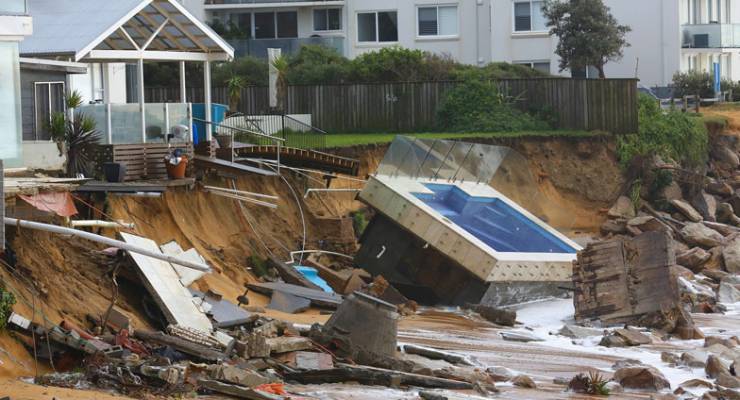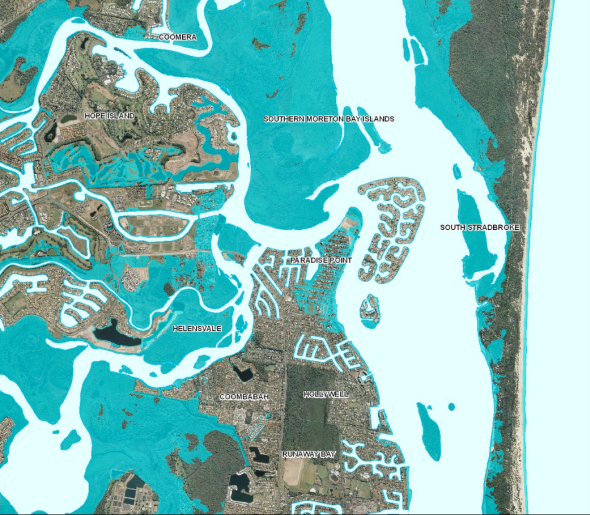
The image of a swimming pool falling into the sea was splashed on front pages of several major newspapers this week as a Sydney storm delivered devastation.
The lesson of the pool that sailed to sea is clear: from now on, nobody should buy a coastal property and expect it not to wash away. And the government must make it explicit it won’t help anyone who does.
Should we compensate landowners whose property is ruined by a combination of storms and sea-level rises? There is a clear case for helping those who bought when the risks were not clear. But we must draw a line in the sand as to when those risks became clear — and the sooner the better.
Should government pay for natural disaster damage?
Governments tend to pay when things go wrong. The humanitarian costs of disaster are sufficient that we simply reach into our pockets — even when the risks were clear in advance.
Christchurch, for example, is in a highly earthquake-prone country. But after the 2011 earthquake, the government made an offer to buy thousands of homes on land that could no longer be safely used.
Similarly, after the Black Saturday bushfires in Victoria, the government instituted a property buy-back for people who bought in the middle of Australia’s fire-prone bushland.
The cost of sea-level rise and storm surges could be even greater than floods or fires, as the land a person owned might not even be there after a severe storm. (In most of Australia the land is worth more than the house on it).
Thousands of people with mortgages, no home and no land would create a humanitarian situation the government would be expected to help resolve.
Beach houses v houses near the beach
The famous picture of the pool doesn’t help us grasp the humanitarian aspect; it makes seaside living look like a rich person’s folly. This is what they call “bad optics”. It makes people say things like, “Oh well, buyer beware.” But a few seaside residents losing their pools is not what we face, as a nation or as a globe.
Of course buying back wealthy people’s holiday homes is a bad use of scarce climate change mitigation funds. But along Australia’s thousands of kilometres of coastline, most at-risk homes are not of that kind.
They are the more humble homes you might find in Seaspray, Victoria or in Burnett Heads, Queensland. Australia has many such towns. The scale of the problem is serious. This is what the old Department of Climate change estimated, in 2011:
“Nationally, between 187,000 and 274,000 residential buildings are exposed to the combined impact of inundation and shoreline recession at a sea level rise of 1.1 metres (high end scenario for 2100).”
Bigger ocean, smaller nation, as sea levels rise
It does seem that 2100 is far off. But more frequent storms, if that is in fact a side effect of climate change, could make long horizons irrelevant. The average sea-level rise is less important if high-energy storms create higher variation around the mean. Frequent storm surges could make lots of land hard to live on, sooner than we think.
The value of potential compensation is huge and that creates a clear moral hazard. Any expectation the government will provide a handout in case of sea-level rises would make coastal property more desirable.
(Actually ruling out compensation may make at-risk properties somewhat harder to sell, and could trap some residents in homes whose values sink as the water rises. That is not ideal but at least has the benefit of confining the problem to the current home-owning generation.)
If a compensation scheme has to exist, its potentially vast cost makes worthwhile investing in preventing sea rises and erosion. Sea walls might not save properties like Collaroy that would face the battering of Pacific Ocean swell, but could be useful for the many estuarine properties around the country.
Here’s an example of such an area in south-east Queensland that is expected to be largely submarine under a 50cm sea-level rise.
Australia is a country that comes to the aid of those hurt by forces beyond their control. But that leaves the public purse open to exploitation by those who want to privatise gains and socialise losses. We should guard against being exploited by making it very clear that future sea-changers will not be publicly insured.









It seems we’re happy to pay farmers for over-committing to transparently risky investments, so why not other rich people too?
People like to build on the front dune. Sooner or later they will learn that the sea gives and the sea takes. Who are we to interfere with their learning process?
Bear in mind that the NZ Government has long maintained a national Earthquake insurance commission (EQC) that prior to the Christchurch quakes of 2011-2012 held $NZ6B. These funds are typically used to provide relief for damages not covered by private insurances. For instance the Christchurch events resulted in the land under houses of entire suburbs being rendered unfit for rebuilding as it had sunk beneath the water table. Peoples home insurances may cover most building costs but it explicitly doesn’t cover the land itself. Owners of coastal property might reflect on that.
T coin (sic!) a phrase “we must draw a line in the sand…”.
Interesting that no-one has commented on the sheer superfluity of living on the beach but having a swimming pool.
Thank you for pointing out that the variation in storm wave heights is even more important (in damage) than the mean rise. Similarly, we must expect more storm surges onto flat land beside the sea.
As implied in another comment, the mere presence of sand dunes implies a transient landscape. Further, the sea has been rising throughout the time that the current owners bought – though only at 1.8 mm/a. Apart from that, local sea level changes when ocean currents change their course, which they are more likely to do in the future.
A lesson that should have been learnt from the Brisbane Floods is that flood plains are called flood plains for a good reason.